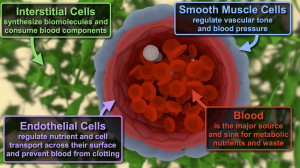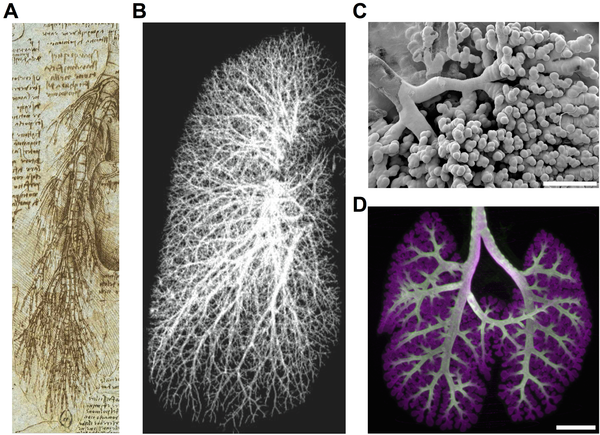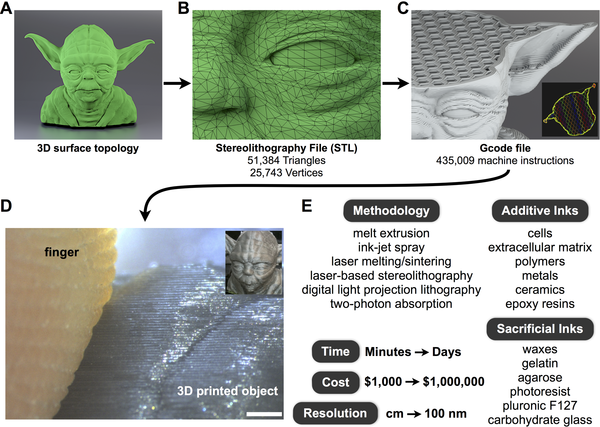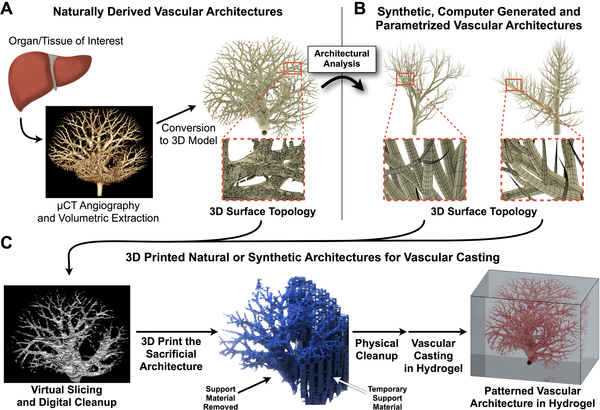Bioprinting has made giant strides over the past few years but many stumbling blocks remain. A recent essay, titled ‘The Billion Cell Construct: Will Three-Dimensional Printing Get Us There?‘, by Jordan S. Miller discusses a variety of issues surrounding this topic. Dr. Miller, a professor in the Department of Bioengineering at Rice University provides critical insight into the advancements made to date. The primary thesis that Miller puts forth  is that while we are making progress in duplicating a single cell or two, of a particular organ, it’s much more complex to do an entire organ.
is that while we are making progress in duplicating a single cell or two, of a particular organ, it’s much more complex to do an entire organ.
He notes that the ultimate goal of bioprinting is to have a methodology in which the printed organ is completely integrated with our anatomy, so as to be essentially untraceable. To be sure, overall advancement in this area has been positive. Looking at such things as knee and hip replacements, or even pacemakers; it is easy to see that this approach has been quite successful. Even with transplants of whole organs “from a human donor into a recipient can provide lifelong benefits when accompanied with immunosuppressive therapy.” Despite this, significant impediments continue to prevent moving forward to larger cell structures.
Researchers have had significant achievements in developing single cells, or in some cases small portions of organ tissues such as the liver. In addition, recent studies have been successful in manufacturing multiply cell applications that could be used in small animals or rodents, “but such thin constructs cannot compensate for a whole liver.” Miller notes that scaling up the size of this process is a major constrain. Cell densities are also proving to be problematic. However, he points out that “Recent efforts in 3D printing are now providing exactly these capabilities.” Further, he says “automation and reproducibility are intrinsically built in.” Bottom line, size does matter, as Miller puts it, “it’s first and foremost a numbers game.”
One of the other road blocks Miller notes is the requirement for an “inexorable need for a continuous supply of oxygen and nutrients to maintain cell viability.” While the medical community has made significant progress in this area, “the challenge remains one of mass transport.” It is not sufficient to just get oxygen and nutrients in, but it must also get waste products out of the tissue. While growth is being made in this area, the need for speed of the procedure cannot be over stated. Biologist know that this process must be completed within hours, “whether in engineered tissues or in donor organs for transplantation.” Speed is essential to a successful outcome.
But as Dr. Miller points out, while 3D printing was originally developed for manufacturing, it’s quickly moving into the realm of the “soft, wet environments where cells function best.” 3D printing is for the most part an interactive, additive technology. This technology does not start with a “block of material and remove what is undesirable.” Rather, additive manufacturing starts with nothing and selectively builds one layer at a time, an object of interest according to computer instructions. This approach provides the flexibility that will need to be incorporate in a bioprinting application. But as promising as bioprinting appears, it can still only be used to provide cells that are based on the outside matrix. At this point, data regarding the internal space is still an unknown. However, the National Institute of Health is developing a data base to serve as a common, community accessible space and a resource for standardized problems and issues. It also encourages the involvement of any interested parties, hopefully expediting the advances needed to grow the overall process.
One might get the idea that Dr. Miller is nothing more than a nay-sayer regarding bioprinting, but that would be incorrect. Rather, his essay should be viewed as a “state-or-the-industry” report. He rightly points out “We are still at the early stages, with access to 3D printing technology expanding at rates akin to the personal computer revolution of the 1980’s.” He is in fact very optimistic with regards to the future of bioprinting and believes that opportunities abound. For example, he sees “immediate opportunities for developers of biomaterial inks and 3D printers to commercialize their work for use in experimental research.” Further to the point, he indicates that “As we look towards the future, the prospect of using a patient’s own cells to develop living models of their active biochemistry as well as functional, life-lasting cellular implants offers potentially revolutionary changes” to healthcare. He believes that bioprinting should be a central focal point for this evolution.
 [Source: PLOS Biology]
[Source: PLOS Biology]
Subscribe to Our Email Newsletter
Stay up-to-date on all the latest news from the 3D printing industry and receive information and offers from third party vendors.
You May Also Like
Precision at the Microscale: UK Researchers Advance Medical Devices with BMF’s 3D Printing Tech
University of Nottingham researchers are using Boston Micro Fabrication‘s (BMF) 3D printing technology to develop medical devices that improve compatibility with human tissue. Funded by a UK grant, this project...
3D Printing Webinar and Event Roundup: April 21, 2024
It’s another busy week of webinars and events, starting with Hannover Messe in Germany and continuing with Metalcasting Congress, Chinaplas, TechBlick’s Innovation Festival, and more. Stratasys continues its advanced training...
3D Printing Webinar and Event Roundup: March 17, 2024
It’s another busy week of webinars and events, including SALMED 2024 and AM Forum in Berlin. Stratasys continues its in-person training and is offering two webinars, ASTM is holding a...
3D Printed Micro Antenna is 15% Smaller and 6X Lighter
Horizon Microtechnologies has achieved success in creating a high-frequency D-Band horn antenna through micro 3D printing. However, this achievement did not rely solely on 3D printing; it involved a combination...































